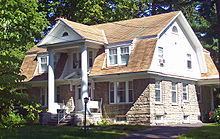- Colonial Revival architecture
-
The Colonial Revival (also Georgian Revival or Neo-Georgian) was a nationalistic architectural style, garden design, and interior design movement in the United States which sought to revive elements of Georgian architecture, part of a broader Colonial Revival Movement in the arts. In the early 1890s Americans began to value their own heritage and architecture. This also came after the Centennial Exhibition of 1876 reawakened Americans to their colonial past, and was accelerated by the advent of the automobile, which allowed ordinary Americans to visit sites connected with the past.
Contents
History
Successive waves of revivals of British colonial architecture have swept the United States since 1876. The books and atmospheric photographs of Wallace Nutting helped spur the style. In the 19th century, the Colonial Revival took a more eclectic style, and columns were often seen.
Three localities that feature larger neighborhood tracts of colonial revival style residences are the Windsor Farms area in the west end of Richmond, Virginia; the Country Club District of Edina, Minnesota, a suburb of Minneapolis; and the Country Club District in Kansas City, Missouri, a residential district lying south and built around the former grounds of the Kansas City Country Club (now Loose Park), and which the J. C. Nichols Company began developing in 1906 to become what is now the largest master-planned community in the United States. All were built in the 1920s.
With the popularity of research-based history attractions like Colonial Williamsburg in the 1930s, the subsequent "colonial" architecture took a more scholarly and less ostentatious turn, and columns fell out of favor. By the 1976 United States Bicentennial, Colonial architecture merged with the then popular ranch-style house design, and created yet another iteration of the Colonial Revival, one that often featured eagle, cannon or drum motifs and sometimes wooden shake roofs. In the early part of the 21st century, styles evolved again, with "colonial" in the United States suggesting a more Anglo-Caribbean or British Empire feel.
In California and the American Southwest, which had been under Spanish and not English colonial rule, revival architecture looked back to Spanish, rather than Georgian prototypes, taking the form of both Mission Revival Style architecture and Spanish Colonial Revival Style architecture.[1]
Defining characteristics
Colonial Revival sought to follow the American colonial architecture of the period around the Revolutionary War, usually being two stories in height with the ridge pole running parallel to the street, a symmetrical front facade with an accented doorway and evenly spaced windows on either side of it.
Features that make them distinguishable from colonial period houses of the similar style of the early 19th century are elaborate front doors, often with decorative crown pediments and overhead fanlights and sidelights, but with machine-made woodwork that had less depth and relief than earlier handmade versions. Window openings, while symmetrically located on either side of the front entrance, were usually hung in adjacent pairs or in triple combinations rather than as single windows. Side porches or sunrooms were common additions to these homes, introducing modern comforts. Also distinctive in this style are multiple columned porches and doors with fanlights and sidelights. To go along with the Colonial Revival style of architecture, owners often sought to furnish the house with furnishings that are preferably antique but often are reproductions.
See also
References
- ^ Elizabeth Jean and Matt Gainer, California Colonial: The Spanish and Rancho Revival Styles 2002.
Further reading
- A. Axelrod, The Colonial Revival in America 1985.
- William Butler, Another City Upon a Hill: Litchfield, Connecticut, and the Colonial Revival
- Karal Ann Marling, George Washington Slept Here: Colonial Revivals and American Culture, 1876-1986 1988.
- Richard Guy Wilson and Noah Sheldon, The Colonial Revival House 2004.
- Richard Guy Wilson, Shaun Eyring and Kenny Marotta, Re-creating the American Past: Essays on the Colonial Revival 2006.
External links
- Photo Gallery of Colonial Revival houses
- Examples of Colonial Revival in Buffalo, New York
- 1876 Centennial Information
- Colonial Revival architecture at Hill-Stead Museum, Farmington, Connecticut
Revival styles in Western architecture and decorative arts International Baroque Revival · Beaux-Arts · Neo-Byzantine · Carpenter Gothic · Châteauesque · Egyptian Revival · Gothic Revival · Greek Revival / Neo-Grec · Moorish Revival · Neoclassical · Renaissance Revival / Italianate · Romanesque Revival · Second EmpireBritish Empire Bristol Byzantine · Edwardian Baroque · Indo-Saracenic Revival · Jacobethan · Queen Anne Style · Scots Baronial Style · Tudor RevivalFrance Germany Greece Portugal Russian Empire and USSR Scandinavia Spain United States Jeffersonian architecture · American Renaissance · Colonial Revival · Mayan Revival · Mediterranean Revival · Mission Revival · Pueblo Revival · Queen Anne Style · Richardsonian Romanesque · Spanish Colonial Revival · Territorial RevivalCategories:- Colonial Revival architecture
- Colonial Revival Movement
- Georgian architecture
- American architectural styles
- House styles
- Revival architectural styles
Wikimedia Foundation. 2010.


